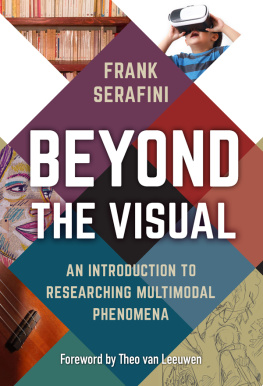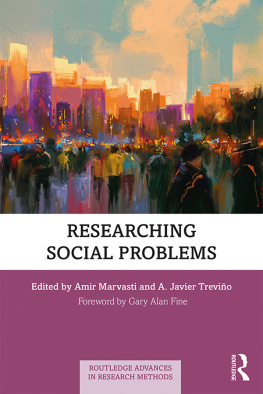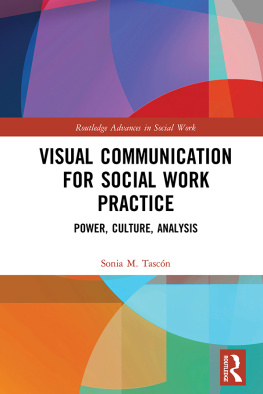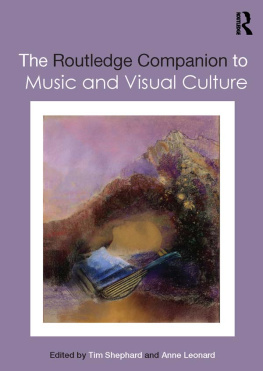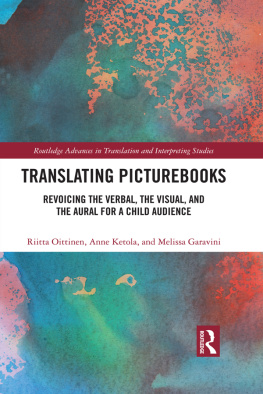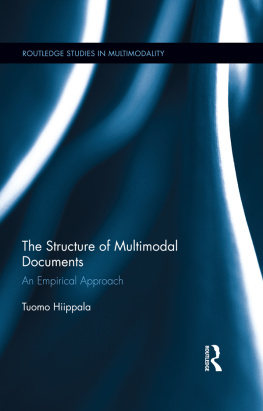Beyond the Visual
An Introduction to Researching Multimodal Phenomena
Frank Serafini
Foreword by Theo van Leeuwen

Published by Teachers College Press, 1234 Amsterdam Avenue, New York, NY 10027
Copyright 2022 by Teachers College, Columbia University
Front cover images: Bookshelves by Tom Page, virtual reality headset by tylim, collage by Danor Shtruzman. ukulele by Keith Cooper, manga by Marika Herzog.
All rights reserved. No part of this publication may be reproduced or transmitted in any form or by any means, electronic or mechanical, including photocopy, or any information storage and retrieval system, without permission from the publisher. For reprint permission and other subsidiary rights requests, please contact Teachers College Press, Rights Dept.:
Library of Congress Cataloging-in-Publication Data
Names: Serafini, Frank, author. | Van Leeuven, Theo, writer of foreword.
Title: Beyond the visual : an introduction to researching multimodal phenomena / Frank Serafini ; foreword by Theo Van Leeuven.
Description: New York. NY : Teachers College Press, [2022] | Includes bibliographical references and index. | Summary: Beyond the Visual is a survey of contemporary approaches to researching a wide range of visual and multimodal phenomena. Bringing together a wealth of analytical approaches, Beyond the Visual works across academic disciplines to share resources for conducting multimodal research across the social sciences. Beginning with a comprehensive overview of the theoretical foundations that support the array of analytical frameworks for researching multimodal phenomena, this book provides examples and outlines for novice and experienced researchers to conduct their own studies. Supported by research vignettes shared by some of the most renown scholars in the field of multimodality, Beyond the Visual provides a survey of fifteen different approaches for analyzing visual and multimodal phenomenaProvided by publisher.
Identifiers: LCCN 2021042845 (print) | LCCN 2021042846 (ebook) | ISBN 9780807766859 (cloth) | ISBN 9780807766842 (paperback) | ISBN 9780807780978 (ebk)
Subjects: LCSH: Visual literacyResearch. | Visual learningResearch. | EducationResearchMethodology. | Visual sociologyMethodology.
Classification: LCC LB1068 .S4678 2022 (print) | LCC LB1068 (ebook) | DDC 371.33/5dc23/eng/20211213
LC record available at https://lccn.loc.gov/2021042845
LC ebook record available at https://lccn.loc.gov/2021042846
ISBN 978-0-8077-6684-2 (paper)
ISBN 978-0-8077-6685-9 (hardcover)
ISBN 978-0-8077-8097-8 (ebook)
This book is dedicated to my wife, Lindsey Moses, for all of her support and kindness throughout the years. You have helped me to see the world as it sees me and have tolerated my lack of decorum at times in gentle and caring ways. I look forward to many more adventures with you. You are truly amazing, and I love you to the moon and back!
Contents
Theo van Leeuwen
Lindsey Moses
Stephanie F. Reid, Danielle Kachorsky, and Kathryn P. Chapman
Peggy Albers
Frank Serafini
Evelyn Arizpe and Julie E. McAdam
Emilia Djonov
Jeffrey B. Holmes, Earl Aguilera, and Kelly M. Tran
Len Unsworth
Jennifer Rowsell
Marva Cappello
Katie Bernstein
Fei Victor Lim
Elisabetta Adami
Kathy A. Mills and Lesley Friend
Kate Cowan and John Potter
Louise Ravelli
Foreword
Multimodality is a key feature of contemporary communication, so it is not surprising that it has moved center stage in many fields. Just as language is not only of interest to linguists, but also to psychologists, sociologists, literary scholars, philosophers, and more, so multimodality is not an exclusive specialty, but of interest to linguists, discourse analysts, rhetoricians, scholars of media and cultural studies, semioticians, and many others. This makes it a complex but also interesting and rich field that offers multiple vantage points that can all contribute to our understanding of multimodal communication.
In this book Serafini sets out to map that complex terrain, surveying a wide range of forms of multimodal inquiry and a vast array of analytical frameworks and methodological choicesmultimodal framing analysis, multimodal genre analysis, multimodal cultural analysis, digitally based multimodal analysis, and critical multimodal analysis, to name just a few of the approaches he reviews. A series of vignettes then shows how well-known researchers use these approaches to investigate multimodal texts, artefacts, spaces, and events, including wine labels, childrens picture books, animation software, video games, and much more.
But Serafini also clearly brings out what all these diverse approaches have in commonthe quest to understand how these different texts and artefacts and events and spaces use semiotic resources to make meaning, and how multimodal analysis, if well contextualized, can yield understandings of social life in a wide range of areas, including education, health care, entertainment, and more. And he also shows that these different approaches, when looked at as practices, as the things multimodal researchers do , have much in common.
There is of course a risk in focusing on multimodal analysis as a practice in this way, the risk of foregrounding analytical procedure over content and rigor over insight, as if all we need to do research is choose an object of interest and a toolbox of choice. This is a risk, because the more explicit and detailed our procedures, the more they can be automatized, and the more they are automatized, the more likely they are to stagnate.
But toward the end of his journey through the vast terrain of multimodal research, Serafini comes to a number of conclusions that counter this risk. Developing a multimodal research project is not a matter of choosing a particular framework from a menu of choices. The choices that exist should, instead, be treated as resources that can be combined and adapted to suit the needs of particular projects in ways that are always to some degree new. Conducting high-quality research requires making connections and alignments among theories, research designs, and analytical procedures (p. 209), he says and we have to rely less on allegiances to established ways of thinking grounded in traditional academic domains and embrace new ways of approaching, conceptualizing, and analyzing contemporary forms, as well as firmly ground our analytical approaches upon a more substantial and expanded theoretical terrain (p. 209).
Closely related to that, he offers another very important piece of advice: Analytical frameworks are also always frames that illuminate certain aspects of a phenomenon and send other aspects to the periphery (p. 210). It is therefore important to begin with an open-minded form of observation that is not yet filtered through a specific analytical framework, to begin with some literal description of the contents being examined before advancing into metaphorical or connotative descriptions and assumptions (p. 113).
All this makes the book more than a taxonomy of fields and subfields, more than a how to textbook providing ready-made recipes. Instead, it opens up the field and shows the next generation of multimodal researchers how much there already is, but also how much there is still to discover, and how much scope for innovation and creativity the field still offers.

